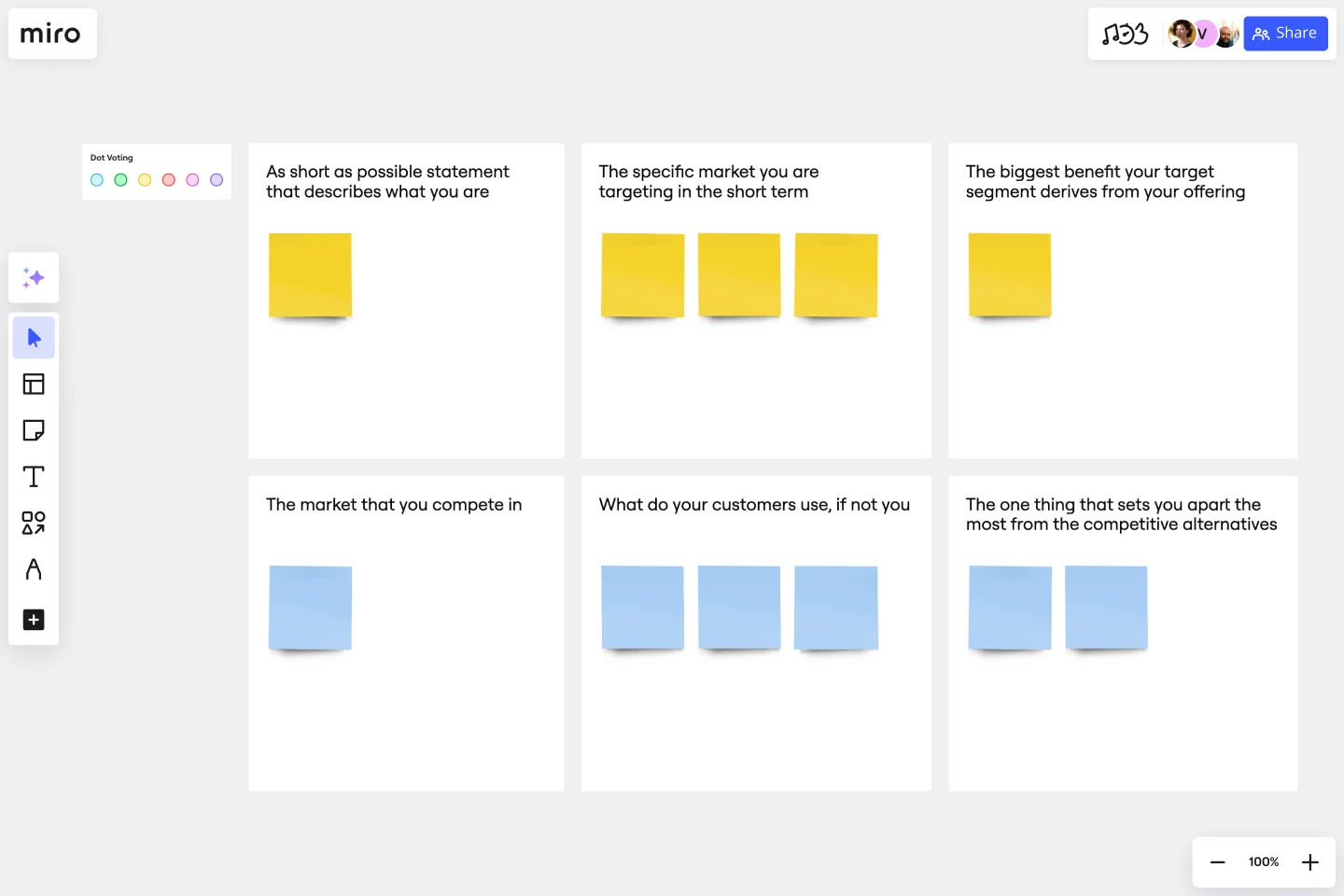Product Positioning Template
Create your strategy for launching a new product or entering a new market with the product positioning template.
About the Product Positioning Template
The success of your company largely depends on the market you are operating in. So, it is necessary to conduct a product positioning exercise before you start building products and planning strategies. This exercise is intended to determine where your company and its offering stands in the market. Although the format of these exercises may differ, it is generally advised to have these objectives in mind:
Define your customer: Who would buy your product or service?
Define the problem: What pain point are you solving for your customer? How does this problem impact your customers? It can also be useful to think about your customers’ experience of this problem. What emotions might they feel when they encounter the problem? This will help you market and design your product offering.
Define key market characteristics: What else do your customers usually buy? How do they buy it? What makes them switch products?
List the other companies in your market: Are these companies your potential partners? Potential competitors? What is their business model? How have they been successful? How have they failed? What is their biggest pain point?
Design an elevator pitch: Your pitch should encompass your customers, their pain points, and how your product is uniquely positioned to solve their problem.
Narrow down your competitors: Now that you have your pitch list your competitors and their strengths and weaknesses relative to your offering.
How to use the product positioning template
The product positioning template is fully customizable, so you can adapt it to your specific needs. Here is a step-by-step on how to use the template:
Step 1: Invite your team members to collaborate on your board.
Step 2: Add the product positioning template. Brainstorm and upload all relevant information to add to each section of the template.
Step 3: If needed, use a Talktrack to share ideas beforehand, and start discussions with your colleagues async.
Step 4: Gather your findings and organize your final product positioning.
Step 5: Present your product positioning directly from the board, print them out, or share them with other stakeholders to gather their feedback.
When should you conduct product positioning exercises?
It is recommended to carry out product positioning exercises whenever launching a new product or entering a new market. Additionally, it is advisable to periodically conduct product positioning to keep up-to-date with the market trends and to stay informed about your product.
Get started with this template right now.
PEST Analysis Template
Works best for:
Ideation, Strategic Planning, Business Management
No business operates inside a vacuum, so if you want to succeed, you have to successfully deal with local laws, government regulating bodies, the health of the local economy, social factors like the unemployment rate, average household income, and more. Use the PEST Analysis Template to help you explore how the world impacts your business and how you can work around it.
Problem Tree Template
Works best for:
Strategy & Planning
The Problem Tree Template is a visual tool crafted to examine a primary issue, its consequential effects, and its foundational causes. Picture it: The tree's trunk embodies the central dilemma, its branches display the direct ramifications, and the roots delve into the underlying reasons. By organizing a challenge in such an illustrative manner, users can comprehensively grasp their situation.
Lotus Diagram Template
Works best for:
UX Design, Ideation, Diagrams
Even creative thinkers occasionally need help getting their creative juices flowing. That's where a lotus diagram comes in. It'll empower you to run smoother, more effective brainstorming sessions. This creative-thinking technique explores ideas by putting the main idea at the diagram center and ancillary concepts in the surrounding boxes. This template gives you an easy way to create Lotus Diagrams for brainstorms, as well as an infinite canvas for the endless ideas generated.
Customer Journey Map by Columbia Road
Works best for:
Customer Journey Map
The aim of the customer journey is to help you break down the customer's activities from both a front-end and back-end perspective.
The Working & Stuck Venn Diagram
Works best for:
Venn Diagrams
The Working Stuck Venn Diagram template helps you identify and resolve project blockages. Use it to compare tasks, resources, and challenges, pinpointing where work is getting stuck. This template facilitates problem-solving and strategic planning, helping teams overcome obstacles and improve workflow efficiency. Ideal for project managers, team leaders, and anyone looking to enhance productivity and ensure smooth project execution.
STAR Technique Template
Works best for:
Strategic Planning, Prioritization
Find out how to use the STAR interview method to identify the best candidate for the role. Interviewees can also use the STAR technique to prepare detailed and thorough responses during the interview.
